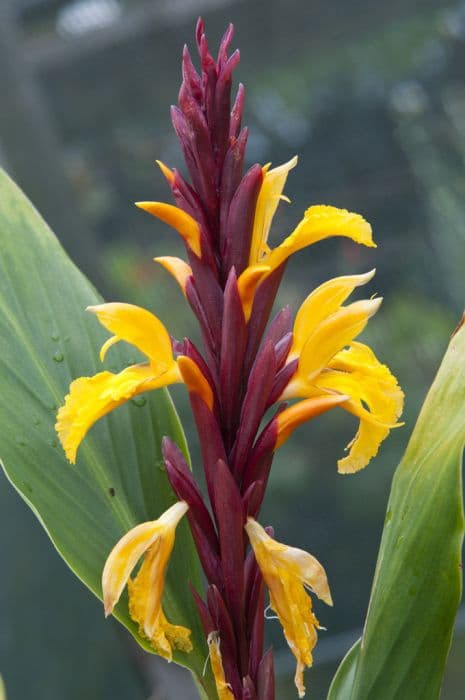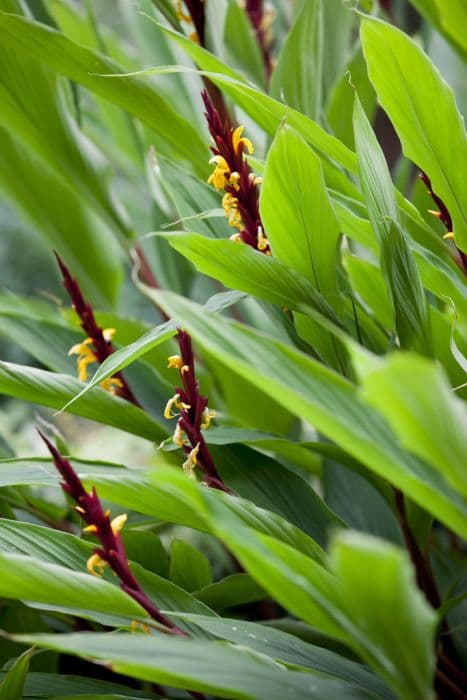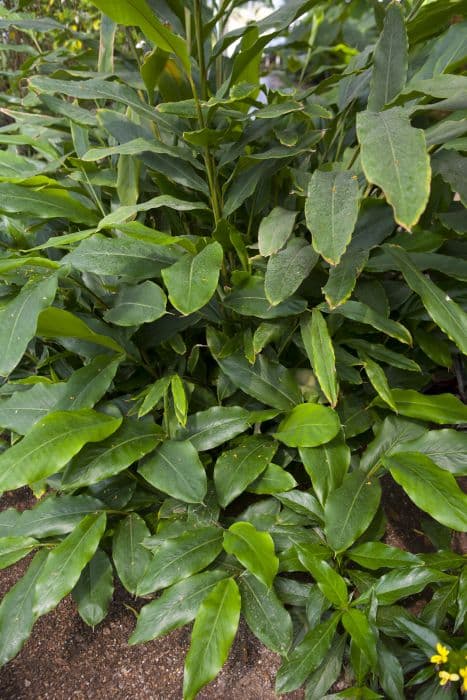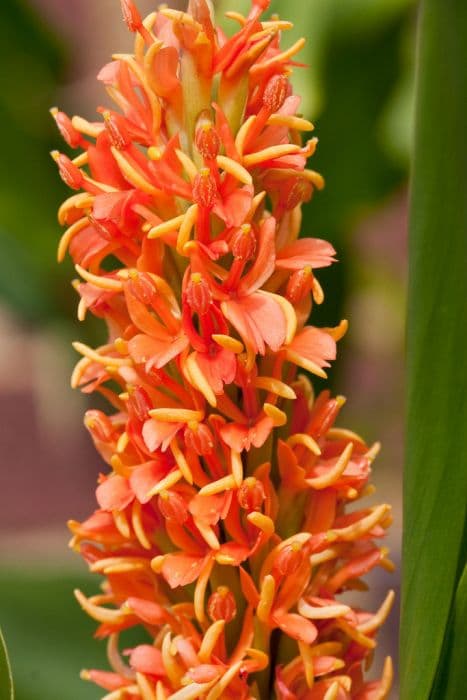Cautleya Spicata Roscoea cautleyoides
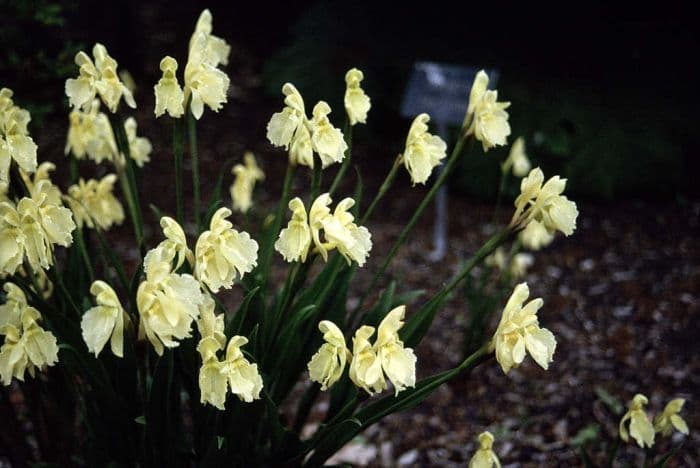
ABOUT
Roscoea cautleyoides, commonly known as Kew beauty, is a perennial plant with a striking appearance. It features lush green, lance-shaped leaves that emanate a tropical vibe. The foliage forms a dense clump, creating a substantial base for the vibrant flowers it produces. The flowers of the Kew beauty are a captivating sight, typically blooming in a shade of purple, lavender, or a pale yellow hue. These blossoms are trumpet-shaped and prominently display a central labellum, which is often a contrasting color with distinct markings that add to the visual appeal. The colorful parts of the flower are supported by thin, delicate stems that rise above the green leafy base. Kew beauty produces these charming flowers during the warmer months, and they often attract pollinators to the garden. The plant carries an exotic feel and lends itself to being a standout feature in garden borders or as a component of a mixed perennial planting scheme. Despite its delicate looks, it's quite hardy and able to withstand a range of garden conditions. In summary, the Kew beauty adds a touch of elegance with its lush foliage and alluring, colorful flowers to any garden setting, capturing the attention of both onlookers and pollinating wildlife.
About this plant
 Names
NamesSynonyms
Cautleya Roscoea, Cautley's Roscoea, Ginger Roscoea.
Common names
Roscoea purpurea var. cautleyoides, Roscoea alpina var. cautleyoides.
 Toxicity
ToxicityTo humans
Roscoea cautleyoides, commonly known as Roscoea, does not have a well-documented toxicity profile with regard to humans. Most sources suggest that it is not toxic to humans, and there are no common reports of poisoning from ingesting this plant. However, as with any plant, individual allergic reactions are possible, and it is generally advisable not to consume parts of ornamental plants without verifying their edibility.
To pets
There is very limited information on the toxicity of Roscoea, or Roscoea cautleyoides, directly relating to pets such as dogs and cats. It does not appear on common lists of plants that are toxic to pets, suggesting that it is likely to be safe. However, in the absence of specific toxicity data, it is always wise to prevent pets from eating plants not intended for consumption, as they could potentially cause an upset stomach or an allergic reaction.
 Characteristics
CharacteristicsLife cycle
Perennials
Foliage type
Deciduous
Color of leaves
Green
Flower color
Yellow
Height
1-2 feet (30-60 cm)
Spread
0.5-1 feet (15-30 cm)
Plant type
Herb
Hardiness zones
6
Native area
Himalayas
Benefits
 General Benefits
General Benefits- Ornamental Value - Roscoea cautleyoides, commonly known as ginger lily, features attractive flowers that can enhance the visual appeal of gardens and landscapes.
- Drought Resistance - Ginger lily is relatively drought-tolerant once established, making it suitable for xeriscaping or gardens with low water availability.
- Pollinator Attraction - The blooms of ginger lily are known to attract pollinators such as bees and butterflies, which are beneficial for the environment and garden pollination.
- Shade Tolerance - Ginger lily can thrive in partial shade, offering an aesthetically pleasing option for less sunny areas of a garden.
- Low Maintenance - This plant generally requires minimal upkeep, making it an easy addition for gardeners of all skill levels.
- Cold Hardy - Ginger lily is quite robust against colder temperatures once established, which is advantageous in temperate climate gardens.
- Seasonal Interest - With its late summer flowering, ginger lily provides interest and color to gardens during a time when many other plants may not be in bloom.
- Container Gardening - Ginger lily can be grown in pots, providing flexibility for those with limited garden space or who prefer container gardening.
 Medical Properties
Medical PropertiesThis plant is not used for medical purposes.
 Air-purifying Qualities
Air-purifying QualitiesThis plant is not specifically known for air purifying qualities.
 Other Uses
Other Uses- Roscoea cautleyoides, commonly known as "Ginger lily," can be used in ornamental gardening to provide a tropical look with its lush foliage and attractive flowers.
- It can serve as a natural pest repellent in gardens due to its strong scent which is not favored by many insect pests.
- In colder climates, Ginger lily tubers can be lifted and stored during winter to be replanted the following season, providing a reusable gardening resource.
- The flowers of Ginger lily are sometimes used in floral arrangements, adding an exotic and colorful touch to bouquets.
- Ginger lily's large leaves can be used as a natural mulch to conserve soil moisture and suppress weeds when decomposed.
- The plant can play a role in erosion control, as its roots help to stabilize the soil in sloped gardens or areas prone to runoff.
- Ginger lily can be planted to provide a privacy screen or green backdrop due to its height and dense growth habit.
- Photographers and artists may use Ginger lily as a subject for its intricate beauty and vivid colors, inspiring creative works.
- Because of its attractive appearance, Ginger lily is sometimes used in educational settings, like botanical gardens, to teach about plant diversity and adaptation.
Interesting Facts
 Feng Shui
Feng ShuiThe Roscoea is not used in Feng Shui practice.
 Zodiac Sign Compitability
Zodiac Sign CompitabilityThe Roscoea is not used in astrology practice.
 Plant Symbolism
Plant Symbolism- Rarity: As Roscoea cautleyoides is not a common plant and is often sought by plant enthusiasts, it can symbolize rarity or uniqueness in a person or situation.
- Adaptability: Given that this plant can thrive in a variety of environments, it may represent the ability to adapt and succeed under different circumstances.
- Beauty in Simplicity: The plant's simple yet striking flowers can be a reminder of finding beauty in the simple aspects of life.
- Resilience: The robust nature of Roscoea cautleyoides, allowing it to thrive in varying conditions, can signify resilience and the ability to withstand challenges.
- Discovery: Because it may be less known to the general public, this plant could symbolize the joy of discovery and the value of exploring the unknown.
 Water
WaterFor Kew Beauty, which is a common name for Roscoea cautleyoides, it's essential to maintain consistently moist soil without waterlogging the plant. During the growing season, water the plant thoroughly once the top inch of soil feels dry to the touch, which typically equates to about once a week, providing approximately 1 to 2 gallons depending on the size of the plant and the environmental conditions. It's vital to reduce watering in the winter when the plant is dormant, allowing the soil to dry out slightly more between waterings. It's best to use a watering can or a gentle stream from a hose to avoid disturbing the soil around the plant's base.
 Light
LightKew Beauty thrives best in partial shade with some morning sun or in dappled sunlight throughout the day. Avoid placing it in locations with harsh afternoon sun which can scorch the leaves. The ideal spot for this plant would be a garden area that mimics its natural woodland habitat, ensuring that it receives the right balance of light and shade for optimal growth.
 Temperature
TemperatureKew Beauty is hardy and prefers cooler temperatures and can withstand a range between 30°F to 80°F. The ideal temperature range for this plant would be between 50°F and 70°F for vigorous growth. Although it can tolerate light frosts, prolonged exposure to temperatures below freezing can damage or kill the plant.
 Pruning
PruningKew Beauty requires minimal pruning, mostly to remove any dead or damaged foliage to maintain its appearance and health. Pruning is best done in the spring, just as new growth appears, ensuring to use clean, sharp pruning shears. Typically, pruning is not required annually; it can be done every few years or as needed when you observe any unsightly or unhealthy stems.
 Cleaning
CleaningAs needed
 Soil
SoilThe best soil mix for Himalayan ginger involves a well-draining, humus-rich medium with a slightly acidic to neutral pH of 6.0-7.0. Mix equal parts of loam, compost, and sharp sand or perlite to promote good drainage and fertility.
 Repotting
RepottingHimalayan ginger should be repotted every 2-3 years or when it outgrows its container, ideally during the spring before new growth begins.
 Humidity & Misting
Humidity & MistingHimalayan ginger thrives in moderate humidity, aiming for a humidity level between 40-60% for optimal growth.
 Suitable locations
Suitable locationsIndoor
Provide bright, indirect light and consistent moisture.
Outdoor
Plant in partial shade with shelter from strong winds.
Hardiness zone
6-9 USDA
 Life cycle
Life cycleRoscoea cautleyoides, commonly known as "Yellow Himalayan Ginger," typically begins its life cycle as a seed that germinates in the spring. After breaking through the soil, the seedling develops foliage and a strong root system throughout the growing season. As a perennial, it enters a dormant phase during the winter, with its foliage dying back and the plant surviving underground as a rhizome. With the return of warmer temperatures, the plant resumes growth, producing new shoots that emerge from the rhizome. Throughout the summer, Yellow Himalayan Ginger blooms, producing distinctive yellow flowers that are pollinated by insects, leading to the production of seeds. After setting seed, the plant's above-ground parts once again die back to the ground as the plant re-enters dormancy, ready to repeat the cycle in the next growing season.
 Propogation
PropogationPropogation time
Early spring
For Roscoea cautleyoides, commonly known as Gingers, division is the most popular method of propagation. The best time to propagate these plants by division is in the spring just before new growth begins. To propagate by division, carefully dig up the rhizomes of an established plant. Using a sharp knife, divide the rhizomes into sections, ensuring that each section has at least one growth bud. After dividing, replant the sections at the same depth they were originally growing, spaced about 8 to 12 inches (20 to 30 centimeters) apart to give them ample space to develop. Water the new divisions well to settle the soil around the roots and keep the soil moist but not waterlogged as the new plants establish.
